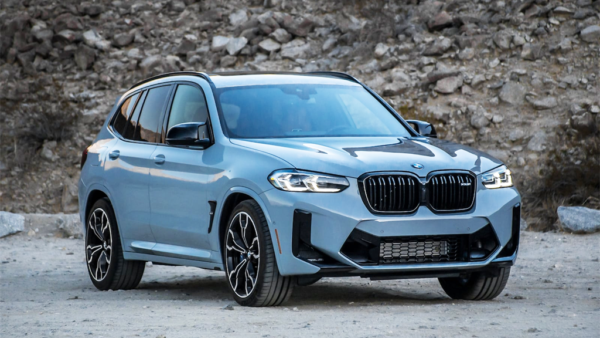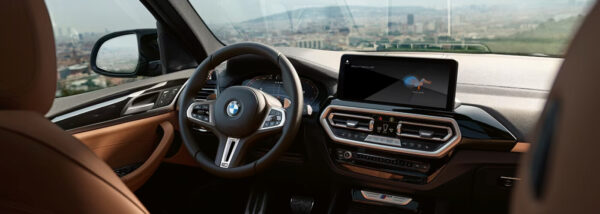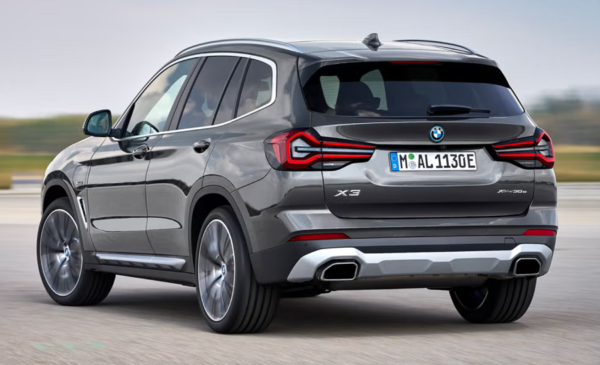Many car enthusiasts appreciate the BMW X3 for what it is: a sporty and inventive take on a German classic. Since its 2003 release, the model has consistently drawn good business for BMW. However, skeptics argue that the car underperforms in many aspects. Luckily, we are here to answer the question: Is the BMW X3 a good car?
The BMW X3 is a car that continues to redefine the compact SUV segment. Finding one better than the X3 might prove difficult as luxury SUVs go. It is renowned for balancing daily drivability with BMW’s hallmark performance. All its models keep this standard up to even the latest. The X3 usually offers two distinct trims: the efficient and refined xDrive and the sporty Mi. The more classic xDrive is for drivers who want a reliable commuter without forfeiting luxury. The Mi, however, is tailor-made for drivers who desire a more spirited driving experience.
So, is the BMW X3 a good car? Let’s find out:
Exterior Build and Design

The BMW X3’s exterior design and overall aesthetic are unique features that set the model apart. The X3 brings an athletic yet refined look to BMW’s lineup. The car’s design highlights BMW’s current styling evolution, with fewer quirks and grooves than the X6. The X3 is equipped with a wide stance and bold proportions. These are additions that make it stand out on any road. One thing that will never change with this model is BMW’s signature kidney grilles. Although on the X3, they are slightly larger but proportionate.
Adaptive LED headlights flank these kidney grilles with a modern, slimmed-down look. These headlights incorporate the latest reflective light technology to give drivers bright and piercing vision in any environment. The X3’s trims also add very distinct exterior design elements. The model boasts accents such as more prominent air intakes, Cerium Gray trim, and dual exhaust tips, emphasizing the unconventional design approach.
Around the back, the X3’s sharp taillight design and integrated rear spoiler enhance its sporty demeanor. Buyers can select from various wheel sizes, ranging from 19 to 21 inches. These additional features accentuate the BMW X3’s popularity in the SUV market.
Interior and Technology
On the inside, the BMW X3 is perhaps one of the most luxurious options in the compact or midsize SUV segment. The midsize X3 delivers a premium experience with BMW’s latest technological advancements. Both trims feature BMW’s Live Cockpit Professional, an innovative display that revolutionizes how we drive. The car is also expertly finished with Sensatec upholstery and finely crafted wood trim. This upholstery is taken up another level with the Mi’s Vernasca leather and aluminum or carbon-fiber trims. This is in addition to adjustable heated seats.
The Live Cockpit Professional combines a 12.3-inch digital instrument cluster with a central 14.9-inch touchscreen. This is the crown jewel in a luxurious dashboard that is irreplicable in other SUVs on the current market. With natural voice commands, BMW’s iDrive 8.5 system makes infotainment control intuitive and responsive. Drivers can enjoy their favorite content just at the touch of a button.
Additional Tech and Safety Features
Additional tech features include ambient lighting, a Harman Kardon sound system, and advanced driver assistance. BMW incorporates lane departure warnings and front-collision alerts for increased safety while driving. Drivers can purchase upgrades and add-on features like a head-up display, gesture control, and BMW’s Parking Assistant Plus.
Engine and Performance
Most cars, like the BMW X3, are not particularly lauded for their engines and road performance. Many believe that cars like this in the SUV market are bought primarily on their look and handle. However, the X3 manages to combine everyday drivability with dominant road performance. Each X3 trim offers a unique powertrain to meet different driver preferences. The xDrivei features a 2.0-liter turbocharged inline-four engine, delivering 248 horsepower and 258 lb-ft of torque.
The Mi offers a different option, sporting a 3.0-liter inline-six engine with BMW’s mild-hybrid technology. This mammoth SUV can generate 382 horsepower and 369 lb-ft of torque. Both trims’ engines pair well with BMW’s unique xDrive all-wheel-drive system. This system enables the xDrivei to achieve a smooth 0-60 mph sprint in 6.0 seconds. The system also rockets the Mi from 0-60 mph in an exhilarating 4.4 seconds.
The xDrivei’s engine is more than well-equipped to get the job done. However, the Mi caters to SUV owners who desire more power on the road. Both models are also equipped with an eight-speed automatic transmission. The BMW X3 delivers precise shifts and a satisfying driving feel, whether cruising or tackling tight curves.
Fuel Economy
The xDrivei returned 24 mpg in highway driving at 75 mph with a range of 500 miles. The Mi achieved 20 mpg with a range of 420 miles. EPA ratings for the xDrivei are 23/20/26 mpg city (combined/highway) and 20/16/22 mpg for the Mi. The BMW X3’s fuel economy is decent but not outstanding, particularly in the Mi trim. The Mi’s fuel consumption is more in line with larger, more powerful vehicles. The X3 may not be the top pick for drivers focused on fuel economy.
Driving Experience and Handling
The BMW X3 is an SUV that combines practicality with a dynamic drive. It especially offers an unmatched balance when driving. Irrespective of terrain, this SUV keeps cruising all through. The car provides a balanced, comfortable ride for urban and highway settings. Its well-tuned suspension soaks up imperfections, and the light steering makes maneuvering through city traffic a breeze.
The Mi, however, turns up the excitement. With an adaptive M suspension, this trim handles close corners with confidence. The driving dynamics offer a connected feel to the road. The adaptive dampers instantly adjust to driving conditions. Both trims are more than capable of maintaining a level of refinement suitable for daily commutes. This is according to remarks about how the X3’s driving dynamics had almost become reminiscent of sports cars and luxury sedans. The X3’s models emphasize a serene driving experience for everyday drivers.
BMW’s optional Dynamic Handling Package adds a sportier edge with improved responsiveness. This car is one of the only ones in the luxury compact SUV market that offers an impressive combination of efficiency and smoothness.
What Year Model of the X3 is best?
To determine whether or not the X3 is a good car, we must look at all its models over the years. The BMW X3 saw a significant overhaul in 2010. This was geared towards making the car more accessible to the performance needs of modern drivers. The pre-2010 X3 models shared similarities with cars like the Honda CR-V, Nissan Xterra, etc. These cars were focused on rugged off-roading as opposed to daily practicality. The BMW X3 overhaul saw it rise to be a consistent best seller. Its yearly models are grouped according to similar features and fixtures.
The 2011-2013 X3 offers excellent value for a budget-friendly option with BMW basics. This was amongst the first vehicles to incorporate the eight-speed automatic transmission. Drivers could now enjoy well-rigged suspension and driving dynamics. They could also enjoy all this at a moderate price. However, as with many older models, you get the essentials but lack some newer conveniences. Nevertheless, its core features and durable build make it a reliable choice if well-maintained.
If budget and reliability are essential to you, the 2014-2016 X3 models are a reliable choice. These models received a much-needed facelift and a more modern outlook. BMW improved the exterior styling and interior materials, along with updated tech. Solid performance, respectable fuel efficiency, and a smooth ride are assured with models like 2016’s xDrive28i. These sturdy SUVs have become a bit dated but still report fewer issues than earlier models. The 2014-2016 X3s made the X3 model a household name in SUVs.
The newer 2017-2020 models offer modern amenities at a more affordable price. They are more than able to deliver on BMW’s promise in modest price ranges. This generation debuted BMW’s updated design language and added more interior space. They became synonymous with comfortable family SUVs in the auto industry. It includes most tech features found in current models, like a high-quality infotainment setup. The M40i model introduced in 2018 brings combines speed with everyday practicality. The 2017-2020 models are ideal for those seeking value without exorbitant prices.
The 2021-2023 BMW X3 stands out for the newest tech and design. The mid-cycle refresh brought sleeker styling and introduced BMW’s advanced iDrive 7.0 system. It also brought with it improved driver-assistance features. A big draw is that the plug-in hybrid xDrive30e provides an impressive fuel economy without compromising power. This is a strong choice if you prioritize top-notch technology and the latest styling.
We primarily contend that the 2017-2020 range of X3s is the best of the model pound-for-pound. The models essentially provide modern design, advanced features, and spacious comfort. All without the exorbitant costs of newer models. It all boils down to a mix of luxury and price here. The best BMW X3 model you should buy is one of those in the 2017-2020 class.
Shortcomings of the BMW X3
The BMW X3 has limited cargo space compared to other cars in the compact SUV class. Although the rear seats fold to expand storage, the X3’s sloped rear design compromises some vertical space. This makes the X3 less accommodating for more oversized items and objects. Families seeking cargo space for bulky gear might find it restrictive. The coupe-inspired design could also be a drawback for those prioritizing utility over aesthetics. Some drivers may find that the style affects the practicality they’d expect from an SUV.
Rear seat comfort in the BMW X3 is another area where it could improve. Sometimes, the rear seats may feel tight for taller passengers. Many owners complain about comfort, especially during longer trips. The legroom is reasonable, but headroom in the back can feel somewhat limited due to the roofline. For a compact SUV, the rear seating is considerably less than spacious.
While the base xDrivei engine delivers enough, some drivers may find it lacks the punch. The xDrivei’s horsepower pales in comparison to other premium compact SUVs. Its 2.0-liter turbo four-cylinder feels slightly underwhelming regarding acceleration and throttle response. The Mi provides a significant performance upgrade but a notably higher price. Buyers may be unable to access the full potential of the BMW X3 car without breaking the bank.
The BMW X3’s optional features and packages also significantly increase the cost. The optional upgrades push it closer to the midsize price range. Adding luxury options, driver-assist technologies, or performance upgrades may not be favorable to some drivers.
Competitive Analysis
The BMW X3 faces stiff competition from luxury SUVs like the Mercedes-Benz GLC, Audi Q5, and Volvo XC60. However, the model holds an edge with its affordability and advanced features. The X3 also stands out against the GLC’s higher starting price and the XC60’s less engaging handling.
Both trims comfortably take on the Audi SQ5 and Mercedes-AMG GLC 43 in the performance segment. The Mi offers a more responsive drive with its potent engine and sporty dynamics. The X3 is more reliable than the SQ5 while remaining well-equipped at a similar price point. For drivers seeking an engaging SUV with luxury and performance, the BMW X3 remains a top choice.
Pricing
Starting at $49,500, the xDrivei provides excellent value with its luxury features. These features include iDrive, a spacious interior, and various standard safety technologies. It is a practical choice for those seeking a luxury SUV with impressive fuel efficiency and a refined ride.
The Mi trim, starting at $61,600, more than justifies its price premium. The X3’s powerful inline-six engine, performance-tuned suspension, and Exclusive M styling cues equip it with a thrilling drive and striking presence. While higher in cost, it remains competitive against performance-oriented rivals.
In the used car segment, the average BMW X3 model costs around $25,000, and $40,000 for well-maintained models. The price varies highly depending on model year, mileage, condition, trim level, and location. Buying a used BMW X3 is a smart, budget-friendly option for a reliable vehicle.
So, is the BMW X3 a good car?
Yes, the BMW X3 is a good car. However, in terms of the price range, it could be considerably better. The xDrivei has a lot of shortcomings that could put off many buyers in the SUV market. BMW’s persistence with its coupe-style design sometimes detracts from practical, everyday use. Ownership reports consistently highlight complaints centered around the sloped roofline impacting practicality. The car would seem less suitable for those prioritizing maximum storage capacity. It is also ill-suited to areas with high fuel costs. There is a reason it is not exactly popular amongst buyers in search of more conventional SUVs.
Of course, the X3 is a good car, but there are many better luxury SUVs on the market. Even compared to other flagship BMW products like the X6. To get the most out of the X3, buyers may find they have to pay for the expensive Mi option.


